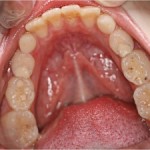
The Scottish Intercollegiate Guidelines Network (SIGN) have just launched a new guideline on caries prevention in children. The guideline replaces two existing guidelines; SIGN 47 on preventing dental caries in children at high caries risk and SIGN 83 on prevention and management of dental decay in the pre-school child. The guideline was developed using SIGN methodology although the GRADE process was not employed for this guideline.
The full guideline runs to 52 pages and covers:-
- Predicting caries risk
- Delivery of dental brief interventions in the practice setting
- Toothbrushing with Fluoride toothpaste
- Other tooth cleaning methods
- Topical anticaries methods.
- Sealants
It also includes some information on the potential resources implications for Scotland of two key recommendations on Fluoride varnish and fissure sealants. In addition a number of potential audits are suggested as well as some recommendations for research.
Not everyone will want to read all the detail provided in the full guideline so a hand quick reference guide (QRG) is also available. The QRG breaks the recommendations into sections with recommendations being graded A B C D to indicate the strength of the supporting evidence.Good practice points ✓ are provided where the guideline development group wishes to highlight specific aspects of accepted clinical practice.
|
Grade of Recommendation |
Recommendation |
| Assessment of caries risk | |
|
C |
As part of the patient assessment, a social history should be taken which will contribute to dental brief interventions being specific to individuals and tailored to their particular needs and circumstances. |
|
✓ |
Dental health professionals should take a common risk factor approach supporting a variety of topic-based brief interventions and when possible provide support to colleagues to expand the delivery of brief interventions across other appropriate settings. |
|
C |
The following factors should be considered when assessing caries risk:
|
|
✓ |
Clinicians should be aware of individuals with a medical or physical disability for whom the consequences of dental caries could be detrimental to their general health. These patients should receive intensive preventive dental care. |
|
D |
Specialist child healthcare professionals should consider carrying out a D caries risk assessment of children in their first year as part of the child’s overall health assessment. |
|
D |
Children whose families live in a deprived area should be considered as at D increased risk of early childhood caries when developing preventive programmes. |
|
✓ |
A child considered by the healthcare professional to be at high caries risk should be referred to the appropriate health service provider. |
| Oral Health Promotion in the practice setting | |
|
B |
Oral health promotion interventions should facilitate daily toothbrushing with fluoride toothpaste. |
|
B |
Oral health promotion interventions should be based on recognised health behaviour theory and models such as motivational interviewing. |
| Preventive treatments | |
|
A |
Fluoride varnish should be applied at least twice yearly in all children. |
|
A |
Resin-based fissure sealants should be applied to the permanent molars of all children as early after eruption as possible. |
|
✓ |
Glass ionomer sealants may be considered if the application of a resin-based sealant is not possible. |
| Toothbrushing with fluoride toothpaste | |
|
✓ |
Children should be assisted to brush their teeth as soon as they erupt. |
|
✓ |
To reduce the risk of mild fluorosis and reinforce good oral health the amount of toothpaste used by children up to the age of three years should be supervised. |
|
A |
Toothbrushing with fluoride toothpaste should take place at least twice daily. |
|
A |
Supervision of toothbrushing with fluoride toothpaste is recommended as an effective caries prevention measure. |
|
✓ |
Children who are unable to brush their teeth unaided should be assisted to do so. |
|
A |
Children should be encouraged to spit out excess toothpaste and not rinse with water after brushing. |
|
✓ |
Children’s teeth should be brushed last thing at night before bedtime and on at least one other occasion. |
|
✓ |
Children’s teeth can be brushed with either manual or powered toothbrushes as an effective means of administering fluoride. |
|
A |
Following risk assessment, children and young people up to the age of 18 A years who are at standard risk of developing dental caries should be advised to use toothpastes in the range 1,000 to 1,500 ppmF. |
|
✓ |
Following risk assessment, children up to the age of 10 years who are at increased risk of developing dental caries should be advised to use toothpastes at 1,500 ppmF. |
|
A |
Following risk assessment, children aged from 10 to 16 years who are at increased risk of developing dental caries should be advised to use toothpastes at a concentration of 2,800 ppmF. |
Comment
The guideline was developed specifically for Scotland and this should be borne in mind when reviewing the recommendations. Please also note that the Dental Elf was the Chair of the SIGN Guideline Development Group.
Links
SIGN 138: Dental interventions to prevent caries in children

“@TheDentalElf: Dental Interventions to prevent caries in children – SIGN Guideline 138 http://t.co/WZ8RW1iVkQ” #Dentistry